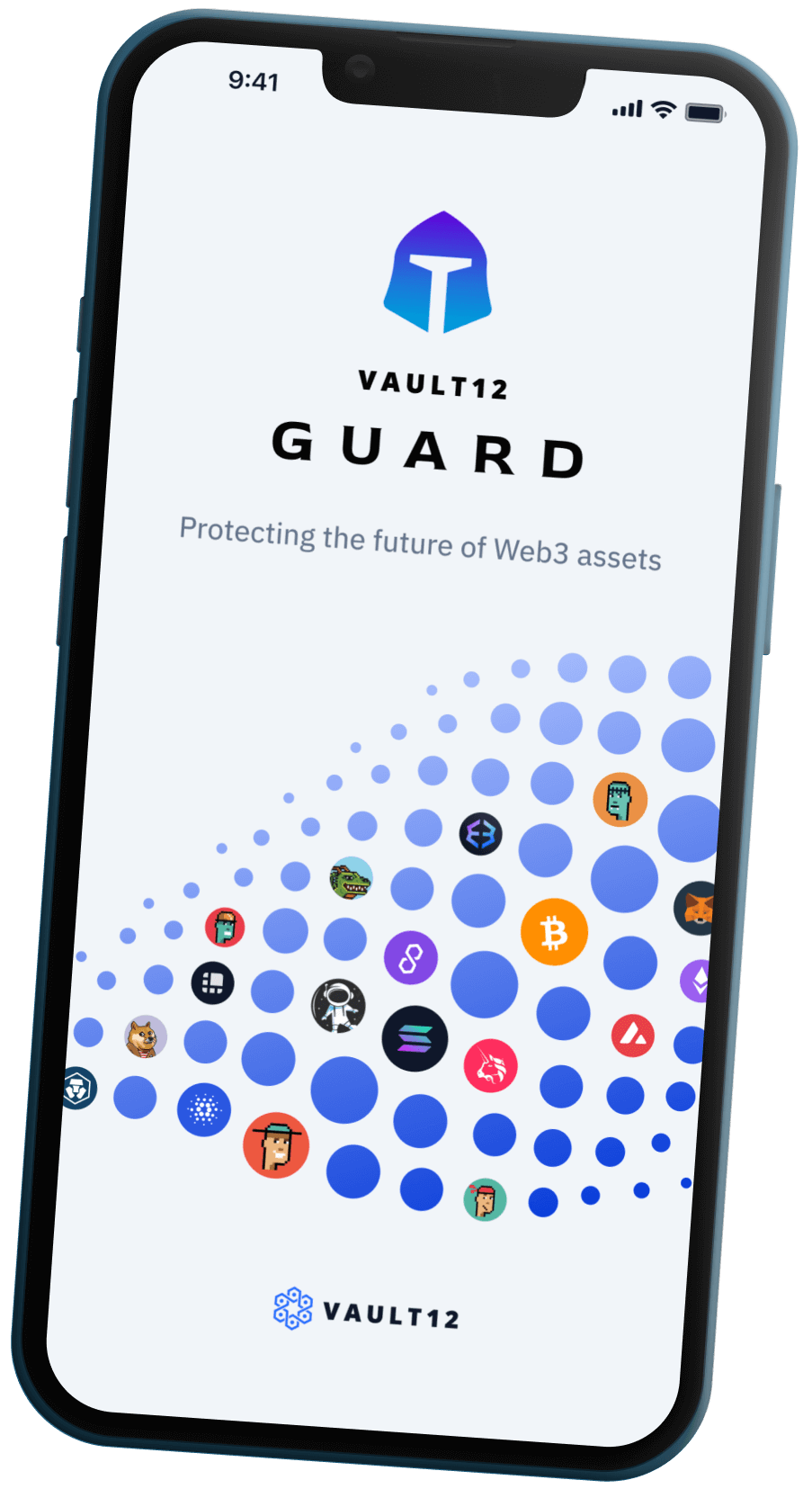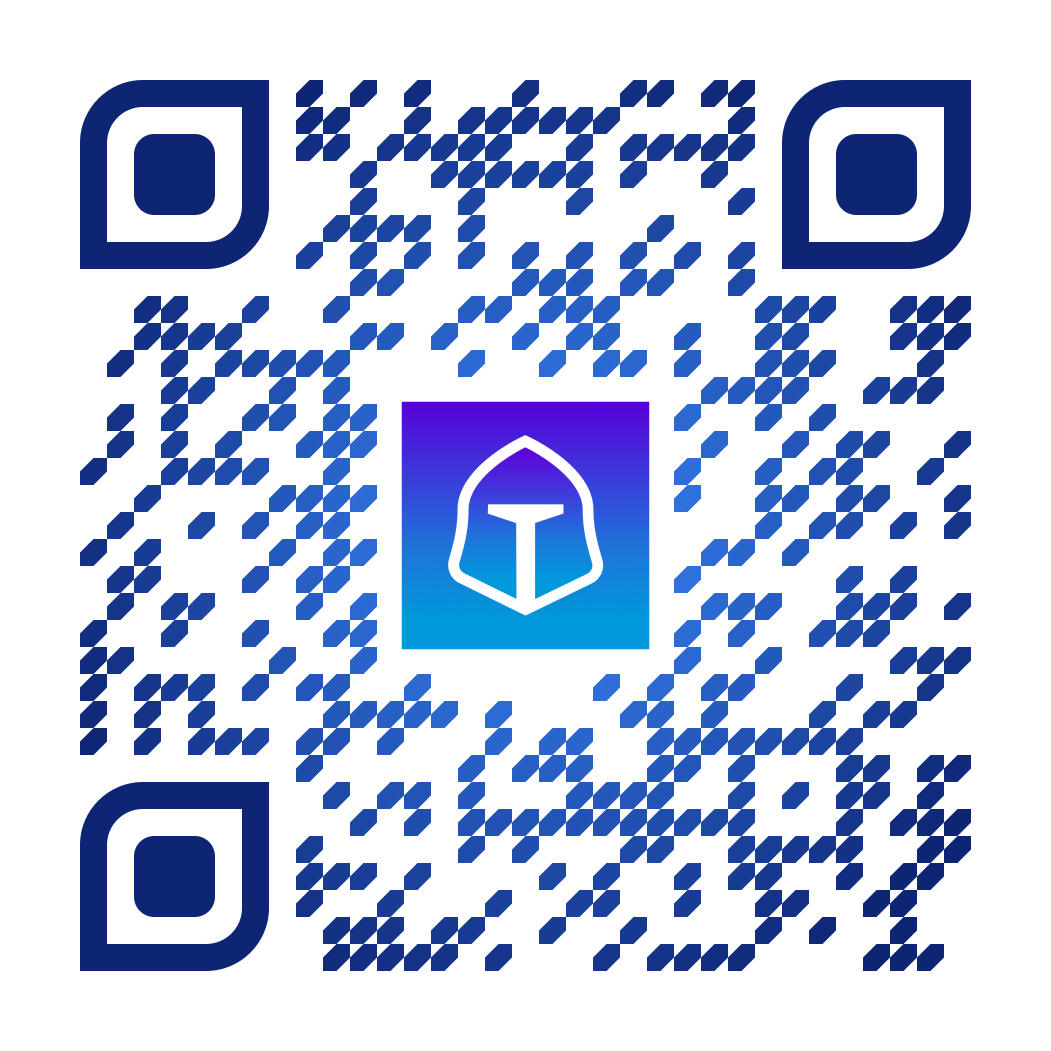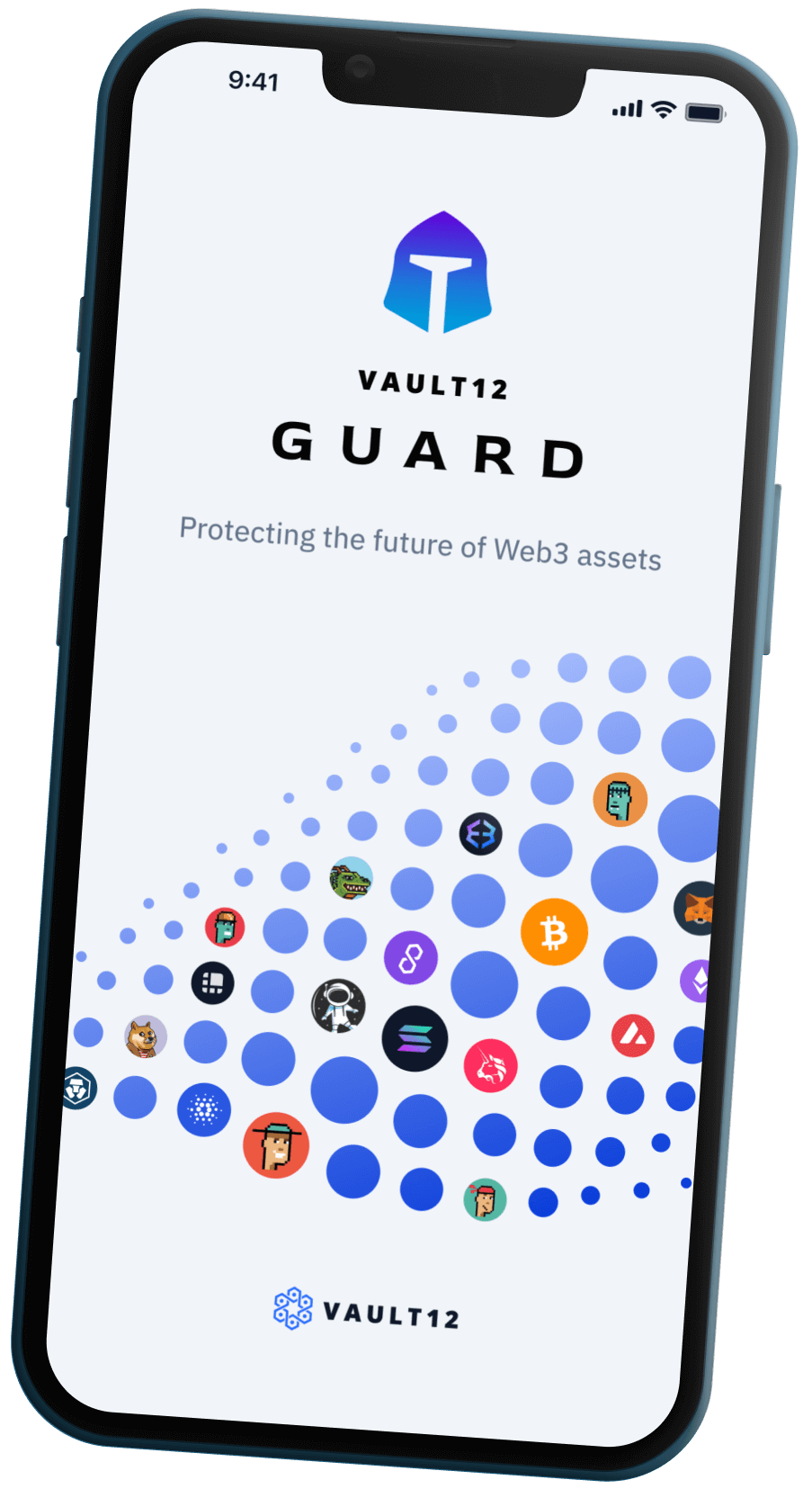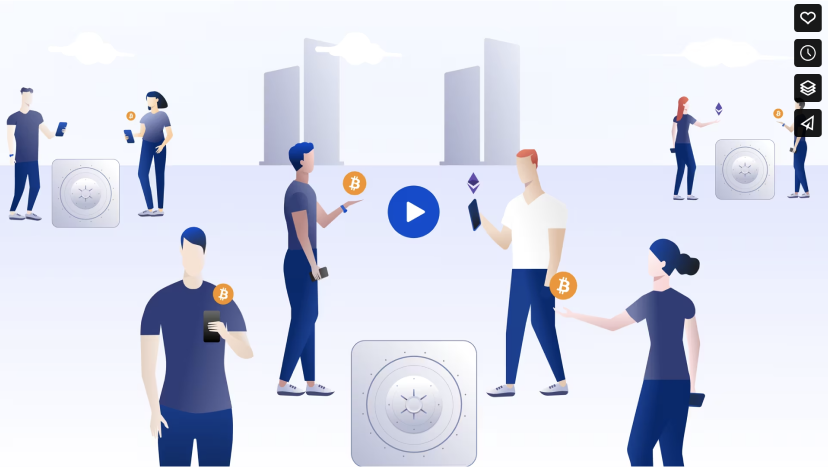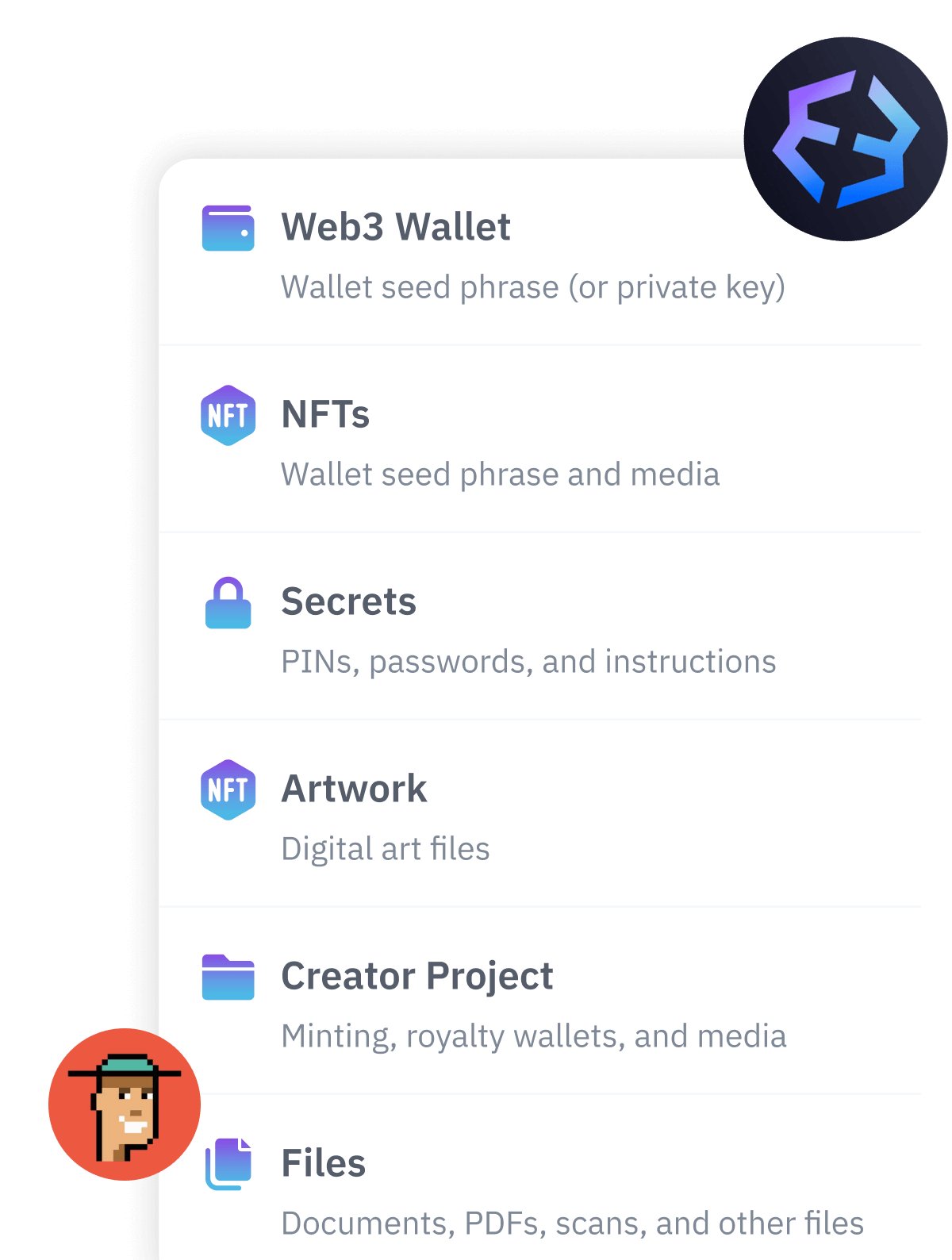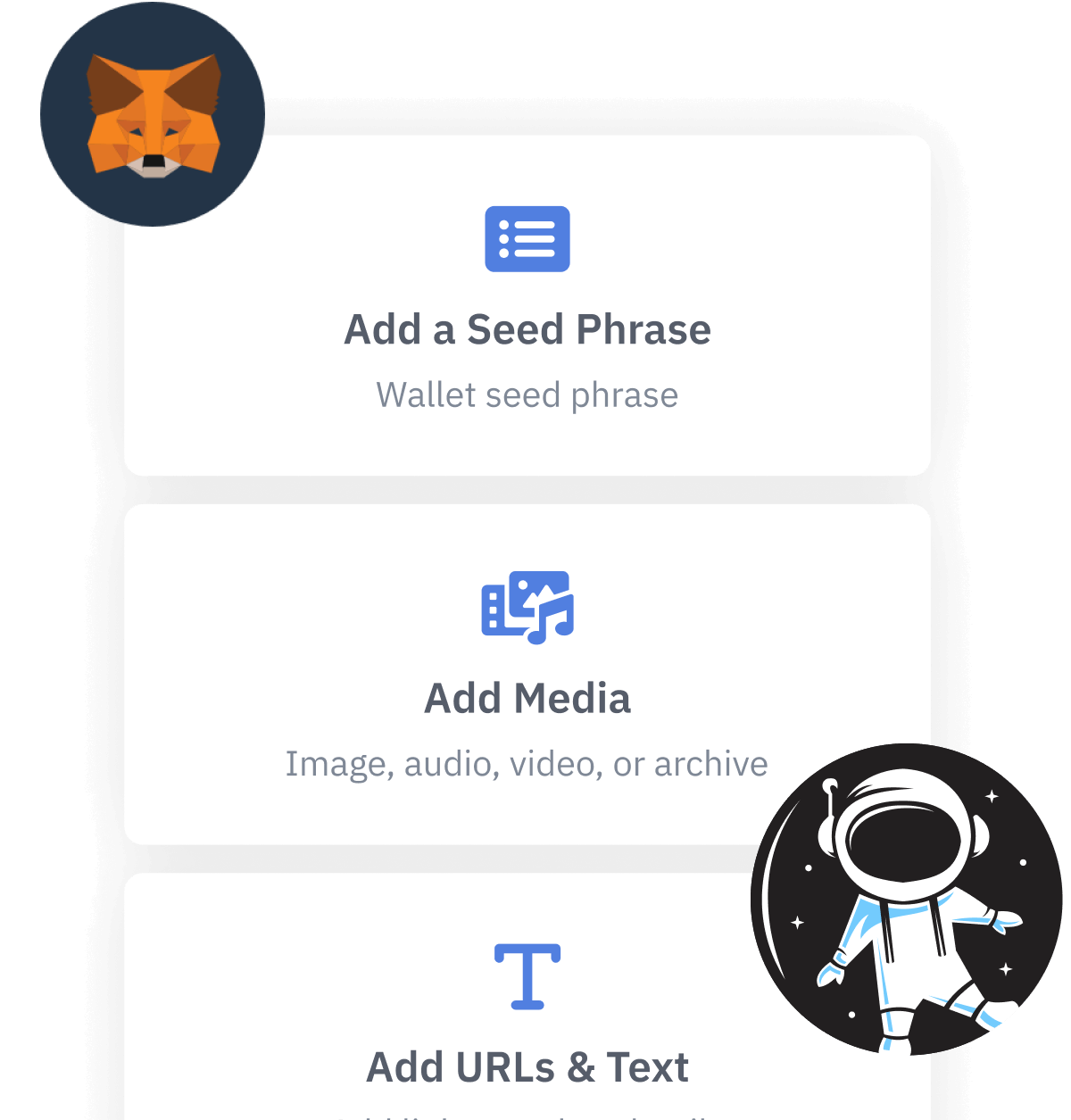
Contents
- Summary
- Inheritance Growth Over The Years
- What Can We Learn From The Past?
- Today’s Challenges
- Who Stands to Gain?
- How Do Digital Assets Tie Into Inheritance?
- Breaking Down Digital Asset Inheritance
- How Vault12 Can Help
- Why Choose Vault12?
- What Benefits Does Vault12 Offer?
- Key Product Features of Vault12 Guard
- How Can Estate Planners Utilize Vault12?
- Sources
The Great Inheritance and Crypto: What you need to know.
The Great Inheritance or The Great Wealth Transfer and Crypto and what it means for you.
The Great Inheritance is here - huge growth in wealth acquisition via Inheritance.
Crypto and Digital Assets make up approx 5-10% $6T in the next 20 years.
Ensure your customers can inherit crypto assets with Vault12.
For $1 a day your customers and their friends a manage their crypto inheritance, easily.
Summary
We are in a unique period of history. Referred to as the Great Inheritance, it is a time when inheritance is the greatest vehicle of wealth accumulation. Over $6T will be passed down to people in 2025 alone, with $80 trillion of assets passing to younger generations over the next twenty years. This means that effective strategies for wealth transfer and wealth acquisition must be in place, including for crypto and other digital assets.
Unlike traditional assets, crypto assets must be documented ahead of time; otherwise, they will be lost and irrecoverable. This requires careful management, as recording information about your crypto wallets (seed phrases and private keys) must be done in a secure and private way; otherwise, should that information get into the wrong hands, these wallets can be emptied ahead of time.
Many solutions exist to document this sensitive information. The problem, however, is that they all suffer from risks and drawbacks. This is why a native solution based on maximizing privacy and security was created by Vault12, the pioneers of crypto inheritance. This process involves securely backing up your crypto wallets, then designating a technical beneficiary. This is done in a simple and easy-to-use fashion, suitable for both the average retail consumer as well as law firms and wealth managers alike.
A little crypto inheritance planning and management will safeguard accessibility to assets from one generation to the next.
Inheritance Growth Over The Years
Image courtesy of The Economist
According to The Economist, inheritance rates are rising to levels not seen since the early 1900s. While this chart measures inheritance as a percentage of national output and not the net value of the inheritance alone, national output has undoubtedly grown globally in most cases over the past century. The Economist states that this year, the total value that will be inherited globally is equivalent to around 10% of global GDP.
What Can We Learn From The Past?
In many cases, inheritance is the largest windfall of value that people will receive at one time in their lifetime. Couple this with it occurring during a period of grief that overwhelms, and it is clear how easy it is to make decisions that lead to value destruction instead of value accumulation.
In the previous chart from The Economist, there is a clear lull in inheritance growth as a percentage of national output in the middle of the 20th century. Back in the 1960s, at the approximate bottom of the chart, it was difficult to access investment products as an average citizen globally. The internet did not exist. There had been no democratization of financial markets. Investment was available to a small portion of the population, and based on the chart, even those who could access it didn’t use it well when it came to maintaining the value of their family’s wealth.
It can be incredibly tempting to spend such a windfall, especially in a time of grief. We see the temptation to “rub your hands in glee and ponder what you ought to do” with your inheritance, as The Economist article describes. It can be surmised that this is why so few of today’s globally wealthy can trace their wealth back to the early 1900s, when the inheritance flow as a percentage of national output was at its highest levels.
Today’s Challenges
In today’s world, even more pitfalls exist than those navigated by the families of the industrial pioneers of the early 1900s. Not only are there more shiny toys to buy than ever before, but access to financial markets has become even more widespread than at any prior point in human history. This means that even if you make the responsible decision to invest some or all of an inheritance, there are more options as to what to do with that money than ever before.
In the age of the internet, someone is promising to change your entire life around every corner with the next incredible investment opportunity. These types of promises can sway people into making poor decisions with their money in any scenario, but especially when they’re in a vulnerable state after a family tragedy.
Image courtesy of The Economist
In their book “The Missing Billionaires,” wealth managers Victor Haghani and James White show that if the millionaires of the past had simply worked with someone who could’ve helped them properly plan what to do with their family fortune, they could have increased the value of each dollar invested by a multiple of six figures over the course of the past century. The Economist uses this historical data to show the value of properly planning and allocating an inheritance.
Applying this lesson to today, more and more people stand to benefit from the work that their parents and grandparents have put in over the course of their lifetimes than ever before. The decision of what to do with this money when the time comes can feel overwhelming, but creating a plan and sticking to it, especially in a time of grief, can lead to preservation and growth of the family fortune for not only you, but your children and grandchildren as well.
Who Stands to Gain?
A recent report, the 2024 Bank of America Private Bank Study on Wealthy Americans, shows key trends related to inheritance, and particularly how younger generations view the future of wealth, including crypto and estate planning. An astounding $84 trillion of wealth transfer is projected over the next 20 years from current generations to Gen X, Millennials, and Gen Z.
According to the report, younger generations (ages 21-42) are more inclined to see digital assets like cryptocurrency as a key growth opportunity. Around 28% of younger respondents ranked crypto as a promising investment vehicle, significantly higher than older generations, where only 4% expressed the same confidence. This highlights the generational shift towards embracing newer financial instruments like blockchain and decentralized finance.
Interpersonal family dynamics can create tension during wealth transfers. For both younger and older wealthy individuals, unequal distribution of assets and a lack of clear instructions or communication were common sources of strain. Younger heirs are more likely to pursue alternative investment strategies, such as private equity and digital tools, reflecting their broader interest in controlling their wealth. These individuals also prioritize sustainability and impact investing as part of their inheritance planning, distinguishing their approach from older generations.
These insights demonstrate the ongoing generational divide in attitudes toward wealth management and the evolving role of digital assets in estate planning.
How Do Digital Assets Tie Into Inheritance?
Given that approximately $84 trillion is projected to transfer from seniors and baby boomers to Gen X, millennials, and their heirs by 2045, Matthew Sigel of VanEck Investments estimates that up to $6 trillion could enter the crypto market through inheritance in the next 20 years.
Why does Sigel believe this to be the case? Well, we can surmise from the earlier information regarding digital asset investment that as this money makes its way down to younger generations, there will be a larger appetite for alternative investments outside of stocks and bonds than there was in previous generations. As a growing and developing new asset class, digital assets will certainly gain their fair share of attention from younger investors, who will be looking to diversify and conserve what will likely be their largest windfall they receive in their lifetimes.
You may think that this would require an immense risk appetite, given the volatility of digital assets in their young existence, but for Sigel’s estimate to be correct, only approximately 14% of this Great Inheritance would need to be allocated to digital assets. Couple this with the fact that younger investors do generally have a higher risk appetite than their older counterparts, and it doesn’t seem that far-fetched that Sigel’s estimate could be accurate, or even fall short of what ends up flowing into digital assets.
Breaking Down Digital Asset Inheritance
Unlike traditional assets, crypto assets need to be managed differently from an inheritance standpoint. In fact, the only similarity between traditional and digital assets is that you must maintain an updated inventory of them. The main challenges associated with crypto inheritance are:
- Ongoing Digital Asset Inventory: You must carefully maintain an inventory of crypto assets. This means backing up seed phrases and/or private keys of all crypto wallets, across all blockchains, and all types of devices or places where those wallets exist, e.g., mobile phones, hardware wallets, cloud, and paper backups. Any assets that are not documented in your backup are liable to be lost.
- Absolute Informational Privacy: You must ensure absolute privacy of the backup information. Anyone with access to private keys or seed phrases will be able to compromise the funds. This includes ensuring that any documentation left with your lawyers is strongly protected.
- Critical Points of Failure: You must eliminate personal devices and cloud services as critical points of failure. The most significant risk in inheritance is reliance on individual devices, which can be stolen, lost, or damaged. The second risk is the dependency on one or more cloud servers. We have seen what happens when business relationships between cloud partners face legal challenges, or cloud services are disrupted by malware or bad software updates.
- Technical Beneficiary Awareness: As the varieties of crypto assets expand over time, staying aware of them becomes important. You will need to designate someone technically fluent in this area. They may not be the ultimate beneficiary; however, you will need to trust them to distribute the assets per your wishes.
- Trust & Estate Attorney: You must consult with experienced lawyers who are well-versed in the inheritance of crypto assets. A great resource is "A Practical Guide to Estate Administration and Crypto Assets" by Richard Marshall from Hill Dickinson LLP.
How Vault12 Can Help
Alright, so you’ve read this far and are convinced that doing nothing and having no plan is not a good idea. However, you also read the part where it is acknowledged that this can be a difficult subject, and you’re curious how to overcome that to ensure that you don’t end up like the families of yesteryear.
The great news today is that there are inheritance management advisors out there who can help you and your family navigate this difficult topic. While this discussion may be difficult to have with your loved ones around the dinner table at a family holiday, setting an appointment with an advisor and making time to be intentional about creating a plan is a great first step in figuring out how best to navigate the future of your family’s finances.
A quality advisor will not only help you avoid all of the pitfalls of trying to invest your inheritance all on your own, but their presence and expertise in navigating these types of conversations with families over the course of their career will help make the topic more palatable for you and your family when you meet with them.
Creating a plan for your family’s existing assets, especially in today’s age, will help protect your family’s legacy from any short-term decisions brought on by grief, confusion, or anger. It is essential to acknowledge these emotions as an integral part of the human experience. Allowing yourself the ability to experience and sort through them without it having a lasting impact on your family’s future is a critical lesson that we all can take from the shortcomings of generations gone by.
Why Choose Vault12?
Vault12 is the pioneer of crypto inheritance management. Vault12 Guard is the first solution to offer a simple, direct, and secure way for all types of investors to ensure that all of their crypto assets can be accessed by future generations.
Just because digital assets are new does not mean that classic lessons of asset management have no applicational purpose in this asset class. Stop to consider traditional approaches to the inheritance of assets, when applied to digital assets, create complexity and risk. Your portfolio of digital assets is continually changing — you cannot rely on doing an inventory once, or for that matter continuously, without assistance.
Taking a simple and direct approach like Vault12 Guard reduces the uncertainty around assets not being available to the designated recipient. It also avoids having to approach and petition each service individually during probate to gain access.
What Benefits Does Vault12 Offer?
Especially in a time of crisis, like in the event of losing a loved one, the less that the family has to put on their plate and struggle through while simultaneously mourning, the better. Vault12 offers a variety of benefits for peace of mind. Let’s walk back through the checklist from before about variables that you’d want to consider when mulling over digital asset inheritance:
- Inventory of crypto assets: The first step in inheritance is backing up all your crypto wallets. Vault12 makes this as easy as possible - despite the appalling lack of usability in current hardware and software wallets. There will always be new crypto assets on new blockchains, and Vault12 can manage any crypto asset on any device, on any blockchain, now and in the future.
- Privacy of all information: Your crypto assets are protected via a Secure Element (Secure Enclave in iOS, and Strongbox on Google Android phones), and the encryption used is Quantum-safe. With this security, no one knows what assets are part of your Vault.
- No Critical Points of Failure: No assets are stored locally, no assets are stored in any cloud, and no assets are stored at Vault12. There are no devices to lose, no paper backups, and no need to manually give encrypted assets to a subset of people. The Vault12 system is decentralized, making it a difficult target for hackers — and in fact for any type of failure.
- Confidence in a Technical Beneficiary: With Vault12, you get to designate a trusted technical beneficiary. Should you change your mind, you can swap them out at any time.
- Flexibility in Trust & Estate Attorney: While regulations and guidelines for inheritance planning can vary from state to state and country to country, Vault12 Guard is designed to be independent of whatever legal framework you choose to govern the inheritance of your assets. Vault12 Guard is simply a transfer mechanism that ensures all your crypto assets are passed from your control to a designated technical beneficiary.
Key Product Features of Vault12 Guard
The Vault12 platform provides your crypto assets with the highest security and strong backup resilience. Vault12 Guard Inheritance enables you to designate a beneficiary (an executor, trustee, or other chosen beneficiary) who can inherit the entire portfolio of digital assets that you choose to store in your Vault. There is no need to update an inventory continually or to issue updated instructions. Vault12 Guard Inheritance allows for peace of mind through the following features:
- Unified Digital Vault: Use Vault12 Guard Digital Vault to store digital assets, including cryptocurrency, financial login information, legal documents, medical records, and more.
- Guardian Network: The Vault is protected by your network of Guardians: friends, family, and/or business associates — people that you know and trust.
- Beneficiary Designation: Designate a beneficiary from your chosen Guardians. A declaration is then digitally signed and can be emailed to other parties, such as lawyers.
- Trigger-Based Access: As a Vault Owner, you can configure a legally-defined trigger, such as incapacitation or death. When the trigger occurs, the beneficiary indicates they are ready to access the digital assets. Assets are unlocked and transferred to the beneficiary only when a designated number of Guardians approve the request.
- Preemptive Veto Option: Should the beneficiary attempt to access the assets before they are intended to, the owner can veto the request before any of the Guardians receive an approval request.
How Can Estate Planners Utilize Vault12?
Would you, an estate planner, be willing to spend only $1 a day to protect your customers’ legacy and expand your customer base? What about offering peace of mind to your customers, especially in their time of need?
Anyone can download and use Vault12 Guard to protect their digital assets; it’s available in the Apple and Google app stores in most countries around the world. However, there is an even larger opportunity for financial institutions to provide crypto inheritance to their customers for as little as $1 a day.
Since Vault12 encourages the use of guardians, people that the customers know and trust, to guard their digital vault, the number of people engaged through the Vault12 product is much higher than any other solution for backup and inheritance. The guardians also get to experience safe and secure management of digital assets through the Vault12 Guard Inheritance program. This makes them more likely to use your services, as well as Vault12, for their own digital asset inheritance needs, given that they have already familiarized themselves with the product.
If you are interested in learning more about Vault12, please visit https://vault12.com/.
Sources
The Economist, 2025
- 2024 Bank of America Private Bank Study on Wealthy Americans, Bank of America
- The wealth whisperers who save super-rich families from themselves
- Inheriting is becoming nearly as important as working
Van Eck/CoinMarketCap, 2024
FT (Capital Group)
- Boomers to Zoomers: Engaging the next generation of wealth
- From widows to CFOs: how women navigate inheriting wealth
- Billionaires amass more through inheritance than wealth
- The great wealth transfer is coming…
- Attracting the next generation of inheritors and self-made wealthy
- Lack of holistic advice drives inheritors to regret
Bank of America Private Bank
- 2024 Study of Wealthy Americans (covers the Great Wealth Transfer, inheritance attitudes, and family dynamics).
UBS
- Own Your Worth 2025 (focus on women & next-gen readiness for the Great Wealth Transfer; includes full PDF).
- Heir dynamics: Money in motion (wealth transfer trends; PDF).
- Billionaire Ambitions Report 2024 (succession, legacies, and inter-gen transfers among billionaire families).
RBC Wealth Management
- Wealth transfer: Are you ready? (survey-based insights; with downloadable guide).
- Wealth Transfer (UK/Europe) (survey of 3,100+ people on giving & inheriting; report download).
J.P. Morgan Private Bank
- How to successfully gift to heirs (2025 thought leadership on distribution, governance & investment strategy for transfers).
- 2024 Global Family Office Report (includes succession planning & next-gen transition).
HSBC Global Private Banking
- Harmony through succession planning (2025) (family-owned businesses in Asia; wealth & business succession; PDF).
- European Family Office Report 2024 (succession preparedness & anticipated transfer timelines; PDF).
Barclays Private Bank
- Family Business Report (commissioned research with a section on the approaching inter-generational wealth transfer; PDF).
Northern Trust
- Wealth & Wisdom Across Generations (how to talk to loved ones about family wealth & transfers; PDF).
Fidelity (Wealth Management / Custody)
- State of Wealth Mobility (2024 study; communication & readiness for transfers highlighted).
- Additional planning content tied to inter-gen transfers (not formal “reports” but authoritative insights).
The Great Inheritance and Crypto: What you need to know.
The Great Inheritance or The Great Wealth Transfer and Crypto and what it means for you.

Wasim Ahmad
Wasim Ahmad is a serial entrepreneur and an advisor in the fields of AI, blockchain, cryptocurrency, and encryption solutions. At Vault12, the pioneer of crypto inheritance, he led private and public fundraising efforts and focuses today on expanding the Vault12 ecosystem. In addition, he is a producer of the upcoming movie 'The Bitcoin Executor'.
His crypto experience began with AlphaPoint, where he worked with the founding team to launch the world's first crypto trading exchanges. Previously he was a founding member of Voltage Security, a spinout from Stanford University, that launched Identity-Based Encryption (IBE), a breakthrough in Public Key Cryptography, and pioneered the use of sophisticated data encryption to protect sensitive data across the world's payment systems.
He has also been very involved with regulatory initiatives in both the US and the UK, providing feedback to the SEC and FCA respectively pushing for expanded momentum for innovation and startups within the regulatory frameworks of both countries.
Wasim served on the board of non-profit, StartOut, and is a Seedcamp and WeWork Labs global mentor.
Wasim graduated with a Bachelor of Science in Physics and French from the University of Sussex.

DepressiveHacks
DepressiveHacks is a writer, investor, mental health advocate, and consultant in the web3 space. Visit http://depressivehacks.com for more info.

Vault12
Vault12 is the pioneer in crypto inheritance and backup. The company was founded in 2015 to provide a way to enable everyday crypto customers to add a legacy contact to their cry[to wallets. The Vault12 Guard solution is blockchain-independent, runs on any mobile device with biometric security, and is available in Apple and Google app stores.
You will lose your Bitcoin and other crypto when you die...
...unless you set up Crypto Inheritance today.
It's simple — if you don't worry about crypto inheritance, nobody else will — not your software or hardware wallet vendors, not your exchanges, and not your wealth managers. So it's up to you to think about how to protect the generational wealth you have created, and reduce the risks around passing that crypto wealth on to your family and heirs. What are the challenges with crypto inheritance?
- Crypto Wallets are difficult to use and do not offer crypto inheritance management. In fact, most of them tell you to write down your seed phrase on a piece of paper, which is practically useless.
- Some people back up their wallet seed phrases or private keys on paper, local devices like hardware wallets or USBs, or in the cloud. All of these options have severe drawbacks that range from hacking to accidental loss to disrupted cloud services.
- Software wallets operate on specific blockchains, yet your crypto assets span multiple blockchains. For inheritance to work, you must be able to manage inheritance across every blockchain — now and forever.
DISCLAIMER: Vault12 is NOT a financial institution, cryptocurrency exchange, wallet provider, or custodian. We do NOT hold, transfer, manage, or have access to any user funds, tokens, cryptocurrencies, or digital assets. Vault12 is exclusively a non-custodial information security and backup tool that helps users securely store their own wallet seed phrases and private keys. We provide no financial services, asset management, transaction capabilities, or investment advice. Users maintain complete control of their assets at all times.
Pioneering Crypto Inheritance: Secure Quantum-safe Storage and Backup
Vault12 is the pioneer in Crypto Inheritance, offering a simple yet powerful way to designate a legacy contact and pass on your crypto assets—like Bitcoin (BTC), Ethereum (ETH) and Solana (SOL) —to future generations. Built for everyday users yet robust enough for the most seasoned crypto enthusiasts, Vault12 Guard ensures your wallet seed phrases and private keys are preserved in a fully self-sovereign manner, across all Blockchains.
At the heart of Vault12 Guard is quantum-resistant cryptography and a decentralized, peer-to-peer network of trusted Guardians. Your critical information is never stored in the cloud, on Vault12 servers, or even on local devices—dramatically reducing the risk of a single point of failure. By fusing a powerful software layer with the Secure Element of iOS devices (Secure Enclave) and Google devices (Strongbox), Vault12 Guard locks down your private keys against present and future threats.
Our innovative approach harnesses social recovery, enabling you to appoint one or more trusted individuals or mobile devices as Guardians. These Guardians collectively safeguard your protected seed phrases in a decentralized digital Vault—so there’s no need for constant lawyer updates or bulky paperwork. Should the unexpected happen, your chosen legacy contact can seamlessly inherit your crypto assets without compromising your privacy or security.
Preserve your digital wealth for generations to come with Vault12 Guard—the simplest, most secure way to manage crypto inheritance and backup.
Take the first step and back up your crypto wallets.
Designed to be used alongside traditional hardware and software crypto wallets, Vault12 Guard helps cryptocurrency owners back up their wallet seed phrases and private keys (assets) without storing anything in the cloud, or in any single location. This increases protection and decreases the risk of loss.
The first step in crypto Inheritance Management is making sure you have an up-to-date backup.
The Vault12 Guard app enables secure decentralized backups, and provides inheritance for all your seed phrases and private keys across any blockchain, including Bitcoin, Ethereum, and others, and for any crypto wallet.
Note: For anyone unfamiliar with cryptocurrencies, Vault12 refers to wallet seed phrases and private keys as assets, crypto assets, and digital assets. The Vault12 Guard app includes a software wallet that works alongside your Digital Vault. The primary purpose of this is to guard your Bitcoin (BTC) and Ethereum (ETH) wallet seed phrases, private keys, and other essential data, now and for future generations.

